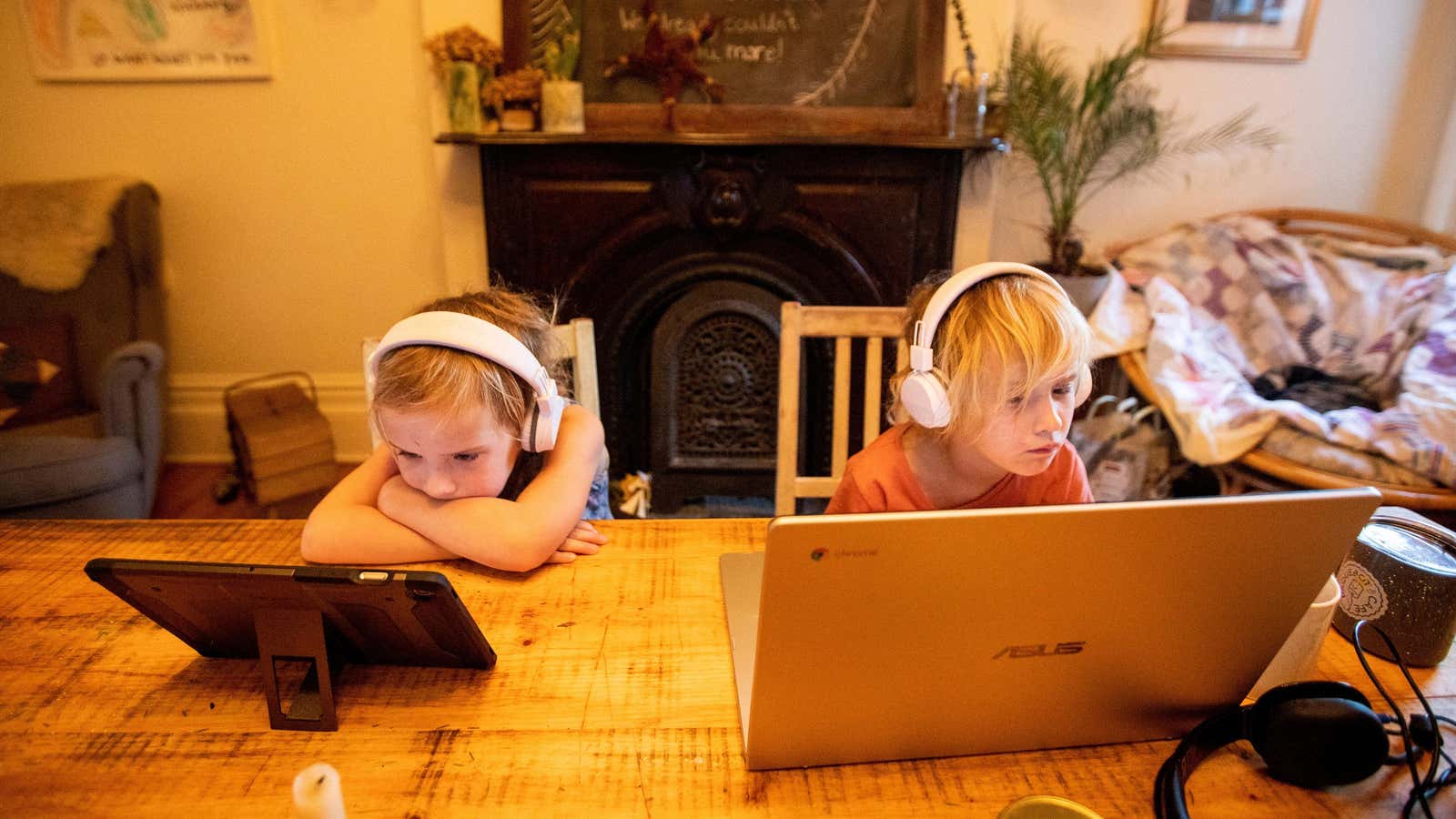Readers without kids may not have heard of CoComelon. Parents of young children, though, will already be picturing the big-eyed 3-D baby at the centre of this kids’ series and hearing the whisper of its ceaseless songs.
Whether or not their kids watch it online, CoComelon’s astonishing popularity makes it hard to avoid. In the US, the show runs on the highest-grossing YouTube channel, earning an estimated $282.8 million since its creation via YouTube advertising.
But CoComelon isn’t the only kids’ channel topping earnings metrics. Children’s content is the biggest earner on YouTube globally. It’s a multibillion dollar business of keeping the world’s youngest people glued to screens in the most effective way possible—a mostly-free childcare service, with consequences that have yet to be measured.
Kids are hooked on YouTube everywhere
Content for children tops the YouTube earnings charts in North America, most of South America, Russia, Sweden, Germany, Portugal, and much of Central and Eastern Europe, Jordan, Israel, India, Indonesia, Thailand, Mongolia, Australia, Turkey, and Kazakhstan. Only in much of Africa do kids’ shows not figure as the most lucrative channels on YouTube. Globally, children’s channels are more popular than gaming channels or those devoted to How-To videos, general entertainment, comedy, or animals, some of the other most popular types of content.
The research, conducted by the loan company CashNetUSA and the social media data firm Social Blade, involved identifying the most popular YouTube channel in every country and estimating its all-time revenue using YouTube’s average payout per thousand views. (YouTube has more stringent advertising rules for content targeted at children.) Googling “CoComelon YouTube” in the UK today (Jan. 30), the first hit was a 30-minute set of songs preceded by five minutes of ads. Ad banners for tech companies and kids’ games flashed across the content often, augmented by sidebar ads.
What does watching YouTube content do to kids?
Plenty of parents have the same debate in their own minds, or with partners and friends: Is letting kids use screens all right, and if so for how long? Research into the question does exist (for example on how screen use impacts sleep) but it offers no easy answer about exactly how much screen time is ok. Recent studies suggest, for example, that “excessive” use of screens makes it harder for kids to regulate their own emotions, and might encourage obsessive-compulsive behavior. But it also depends on what the child would be doing if they weren’t watching a screen. If they’re missing out on physical activity, play, or social interaction, then the answer, quite clearly, is that the screen is not a good use of time. If, on the other hand, they’d otherwise be ignored, bored, or frustrated, that’s a different matter. Children’s shows can be educational, teaching facts or modelling empathetic behavior.
Parents, meanwhile, sometimes need to get things done—like making dinner—or require breaks to preserve their own mental health in a state that can deal with the high-energy task of looking after children. These are global truths. Outside the West too, therefore, channels featuring animated nursery rhymes or counting songs rack up the most views: Chu Chu TV Nursery Rhymes and Kids Songs in India, for instance, or Israel’s TuTiTu TV. In Russia, the massively popular show Like Nastya departs from the animated mould by featuring a child actor in the fantasy-filled life of a small girl, her family, and her friends.
How many hours should a child watch TV?
Given all this, if just half the 22.9 million under-fives in the US watched a screen for ten minutes a day, that’s still 800 million minutes of collective watching—enough to make a channel very lucrative.
Data suggest that many children are watching a lot more than that, however: up to six hours per day for American children aged 8-12, and more for teenagers. The most popular global YouTube sites, meanwhile, like CoComelon and others that feature nursery rhymes, songs, animals, and babies, are aimed at very young children. The American Academy of Pediatrics suggests that children under 18 months shouldn’t use digital media at all, apart from cameos in video calls. Kids under five should watch under an hour of “high-quality” television per day, which parents should watch at the same time, helping their child to engage with it in creative ways.
Kevin Mayer, co-founder of Candle Media, which owns the company behind CoComelon, told Variety this month that the program was born out of the realization that a lot of parents “are parking their kids in front of an iPad and putting on YouTube,” and that content to feed that search would do well. A 2022 New York Times article details how the development process for the show involves trying to distract toddlers from watching it. If they do become distracted, the makers conclude that the content needs to be more absorbing still.
For parents who work without adequate childcare, or have other responsibilities alongside caring for very young children, screens might feel extremely necessary. But their use as a babysitter for long periods of time is almost certainly going against the findings of research on how to have healthy, happy kids.
